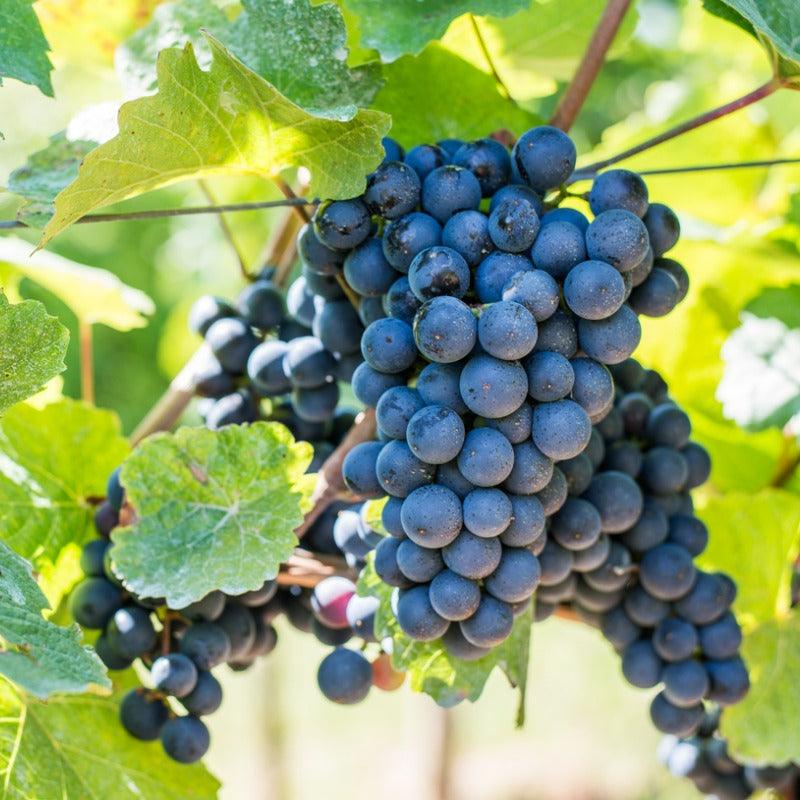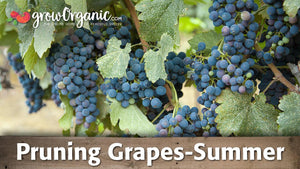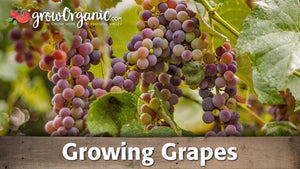Item Number: FV016
Grape Autumn Royal Seedless Grape Vine
Deep purple grapes with bold sweetness.
Mix-and-match for free shipping when purchasing 6 or more perennial berries, vines, or crowns!
Autumn Royal Seedless grapes are a late-season delight, offering large, sweet fruit with deep purple skin and a firm texture. These grapes are perfect for fresh eating, adding to cheese boards, or gourmet snacking. Thriving in full sun and well-draining soil, Autumn Royal vines are vigorous and productive, delivering an abundant harvest in the late season. With their striking appearance, delicious flavor, and long shelf life, Autumn Royal Seedless grapes are a premium addition to any home garden or vineyard.
- Bare Root Vine
- Variety: American
- Zones: 6-10
- Pruning: Cane or Spur Prune
- Harvest: August - September
- Fruit: Black-skinned oval grape, large natural size and late maturity
- Facts of note: Crisp, firm texture and a well-balanced sweetness, these grapes are ideal for snacking, adding to fruit salads, or enhancing a variety of recipes
Autumn Royal Seedless grapes are a popular choice for growers looking to produce high-quality table grapes with exceptional flavor and texture. As an American variety, these grapes are well-suited to a range of climates and offer a rewarding option for both experienced and novice grape growers. Known for their large, black-skinned, oval shape and late maturity, Autumn Royal Seedless grapes are valued for their crisp texture and well-balanced sweetness, making them an excellent choice for fresh eating and a variety of culinary uses.
Growing Grapes: Autumn Royal Seedless Grape Vine
Autumn Royal Seedless grapes are ideally suited for USDA hardiness zones 6-10. This variety thrives in climates with warm to hot summers and a long growing season, which allows the grapes to fully ripen. They are well-adapted to a variety of soil types but perform best in well-drained, moderately fertile soils. Loamy or sandy loam soils with good drainage are particularly beneficial, as they help prevent waterlogging and root diseases.
When selecting a site for planting Autumn Royal Seedless grapes, consider an area with full sun exposure. Grapevines require ample sunlight to produce high-quality fruit, so choose a location that receives at least six to eight hours of direct sunlight per day. Additionally, ensure the site has good air circulation to help reduce the risk of fungal diseases.
Grape Pruning for Autumn Royal Seedless
Pruning is a critical aspect of grapevine management, impacting both fruit production and the overall health of the vine. Autumn Royal Seedless grapes can be pruned using either cane or spur pruning methods, depending on the grower’s preference and the specific growing conditions.
Cane pruning involves selecting one or two canes from the previous year’s growth and cutting them back to approximately 8-15 buds each. This method is often used in cooler climates or where the vines are less vigorous. Cane pruning helps maintain a balanced vine and encourages the production of high-quality fruit.
Spur pruning, on the other hand, involves cutting back the previous year’s growth to short spurs with 2-3 buds each. This method is suitable for warmer climates where the vines tend to be more vigorous. Spur pruning helps manage vine vigor and ensures a good balance between vegetative growth and fruit production.
Pruning should be carried out during the dormant season, typically in late winter or early spring before new growth begins. Proper pruning promotes better airflow around the vine, reduces the risk of disease, and ensures that the vine’s energy is directed towards producing high-quality fruit.
Watering and Fertilizing
Autumn Royal Seedless grapes require consistent watering to support healthy vine growth and fruit development. While established vines are somewhat drought-tolerant, regular watering is important, especially during dry periods. Deep, infrequent watering is preferred, as it encourages the development of deep roots and helps the vine access moisture and nutrients from the soil.
Fertilization should be managed carefully to avoid over-fertilizing, which can lead to excessive vegetative growth and reduced fruit quality. A balanced fertilizer applied in early spring supports healthy vine growth and fruit set. Organic compost or well-rotted manure can also be beneficial, providing a slow release of nutrients and improving soil structure.
Monitor the vines throughout the growing season for signs of nutrient deficiencies or imbalances. Adjust fertilization practices as needed based on the specific needs of the vines and the results of soil tests.
Managing Pests and Diseases
Autumn Royal Seedless grapes, like all grapevines, are susceptible to various pests and diseases. Common fungal diseases include powdery mildew, downy mildew, and botrytis bunch rot. Powdery mildew appears as a white, powdery coating on leaves and fruit, while downy mildew causes yellow or brown spots on leaves. Botrytis bunch rot, also known as gray mold, affects the grape clusters, particularly in humid conditions or after rain.
To manage these diseases, it is important to maintain good air circulation around the vines by pruning and spacing them appropriately. Regular fungicide applications, such as sulfur or copper-based products, can help control fungal outbreaks. Additionally, keeping the vineyard clean by removing fallen leaves and debris can reduce the risk of disease.
Pests like grape leafhoppers, spider mites, and aphids can also impact the health of Autumn Royal Seedless vines. Introducing beneficial insects, such as ladybugs and predatory mites, can help control pest populations. For more severe infestations, targeted insecticides may be necessary, but their use should be minimized to protect beneficial insects and pollinators.
Harvesting Grapes: Timing and Technique
Autumn Royal Seedless grapes are typically harvested between August and September, depending on the climate and growing conditions. The grapes are known for their large, black-skinned, oval shape and crisp texture. They should be harvested when they have reached full ripeness, as this is when their natural sweetness and flavor are most pronounced.
To determine the optimal harvest time, regularly monitor the grapes for changes in color, texture, and taste. The grapes should have a deep, rich color and a firm, crisp texture. Taste the fruit to ensure it has reached the desired sweetness and flavor profile. Since the grapes are late-maturing, be prepared to monitor them closely as the harvest period approaches to ensure they are picked at their peak.
When harvesting, use clean, sharp pruning shears to cut the grape clusters from the vine. Handle the grapes gently to prevent bruising or damage, as this can affect their quality and shelf life. Harvest the grapes promptly once they are ripe, as overripe fruit can become soft and prone to spoilage.
Uses of Autumn Royal Seedless Grapes
Autumn Royal Seedless grapes are highly versatile and well-suited for a variety of culinary applications. Their crisp texture and balanced sweetness make them ideal for snacking, adding to fruit salads, or incorporating into various recipes. They can also be used in desserts, such as tarts or fruit compotes, or enjoyed on their own as a refreshing treat.
While Autumn Royal Seedless grapes are primarily grown for fresh consumption, they can also be used in wine production. However, their main appeal lies in their excellent qualities as table grapes, which are appreciated for their size, flavor, and texture.
Conclusion
Growing Autumn Royal Seedless grapes offers many benefits, from their excellent flavor and texture to their versatility in various culinary uses. By selecting an appropriate site, employing effective pruning techniques, and managing pests and diseases, growers can achieve successful fruit production and enjoy the rewards of high-quality grapes. Whether enjoyed fresh or used in recipes, Autumn Royal Seedless grapes are a valuable addition to any vineyard, offering both beauty and deliciousness.
Visit our Berry, Vine & Crowns Characteristics Chart to compare growing characteristics for all our berries, vines, and crowns.




Check Your Zone Compatibility:
Compatible with your zone.
Growing Zone for

Our Guarantee To You
Since 1976, we've served our customers at every stage of growing. Please contact us at any time. We are happy to support and assist you.
Shipping Information
Shipping Information
Cannot ship to the following states: HI , AK , PR , GU , VI , OR , WA , ID
Cannot ship via USPS.
Cannot ship via SmartPost.
Shipping Weight: 3.3 lb
Dimensions: 36.0"L x 4.0"W x 4.0"H
Features
Features
Characteristics
Characteristics
Planting & Care
Planting & Care
Useful Information
Useful Information
Guarantee
Guarantee
Limited Dormant Tree & Plant Guarantee
* Claim deadline is June 15th
We guarantee that your dormant tree or plant will arrive in good, viable condition. If your tree arrives in substandard condition, notify us within 3 days of delivery. Please email pictures of the box, inside packaging, the tree and its roots to helpdesk@groworganic.com. We will investigate your claim and process a request to exchange or refund the damaged product.
If your dormant tree or plant has not grown new leaves by June 15th, you may be eligible for our Limited Dormant Tree & Plant Guarantee. This guarantee provides for a store credit for the purchase price of the tree, excluding shipping. Please see the Instructions below.
Important Dates:
- April 1st Dormant trees/plants must be planted in the ground
- May 15th Perform scratch test, if no new leaves have grown
- June 15th Deadline to apply for a dormant tree/plant credit
All required documentation must be received by June 15th for your claim to be considered. Claims or documentation received after June 15th will be denied, without exception. Instructions listed below
Terms and Conditions
We cannot guarantee that your tree or plant will remain alive and healthy after it is received, or bear fruit as there are too many variables in your environment that are beyond our control (i.e. soil preparation, weed and pest control, proper irrigation, chill hours, compatible hardiness for your growing zone, proper choice of pollinator, extreme weather, rodent damage, disease, etc.).
We cannot guarantee that we will be able to provide a replacement tree/plant of the same species either that same growing season or in future years. Customers are responsible for all shipping fees associated with replacement trees and plants.
If we determine that the tree you purchased directly from us is not viable, we will issue you a store credit (not a refund) for the purchase price of the affected dormant tree or plant. Shipping is not included in the dormant tree/plant guarantee. Store credits can be used to purchase any product we sell and are valid for use only until July 1st of the following year.
Historically, 98% of our dormant trees and plants grow and thrive when they have been cared for and planted using our growing guides. Dormant trees and plants must be planted in the ground by April 1st in order to be eligible for credit. If the ground in your area is still frozen solid, you may temporarily plant your tree or plant in a pot.
Potted, non-dormant trees or plants are excluded from this guarantee as they are not dormant at the time of shipment. Evergreen trees such as citrus, avocado and olive trees are not available for credit under the Dormant Tree and Plant Guarantee.
Instructions
We guarantee that your dormant fruit tree or plant will leaf out, if you care for it according to our growing guides. In the unlikely event that your dormant tree or plant does not have leaves by May 15th, follow these simple steps to apply for a store credit:
Before you call or email, please perform a “scratch test” to determine if the tree or plant is still alive. This video shows how to check for live tissue under the bark. Scratch tests need to be done a few inches above and below the graft.
Green Cambium Layer / Living Trees
If the cambium layer under the bark is green, give your tree a little more time. It is still alive, but hasn’t come out of dormancy yet. Check to make sure that it is getting the right amount of deep root water, enough sunlight and that the weather is warm enough for that type of tree/plant to come out of dormancy. Every tree has its own personality and will come out of dormancy at different times. Be sure to submit the required documentation listed below by June 15th, if it doesn’t grow leaves.
Brown Cambium Layer / Dead Trees
If the scratch test shows a brown cambium layer or if your dormant tree/plant doesn’t have leaves by June 1st, please email us at helpdesk@groworganic.com. All required documentation listed below must be received by June 15th for your claim to be considered. To be considered for the guarantee claim, all required documentation must be received by June 15th. Incomplete submissions will be denied.
Required Documentation
- Order number
- Name of dormant tree/plant and the quantity affected
- Photos of each tree or plant showing:
- The roots (tree or plant must be pulled out of the ground)
- The scratch test areas
- The entire tree/plant
We reserve the right to not issue credit for items that have already been replaced. We also reserve the right to require photographic evidence that the tree/plant was not killed by root rot, rodent or mechanical damage.
Share
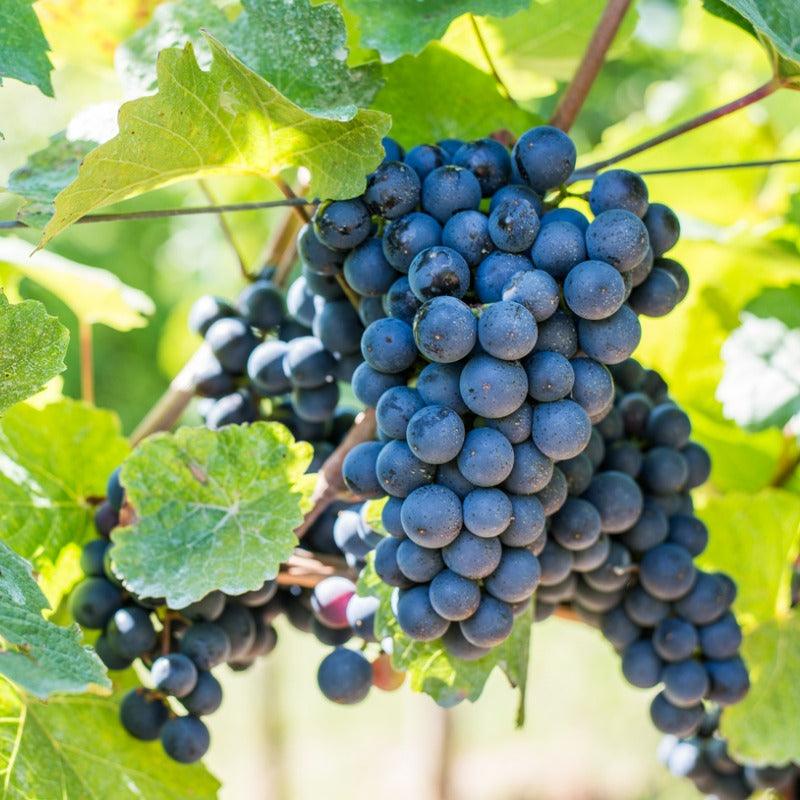
Looking good and quality products
Videos
Articles
-
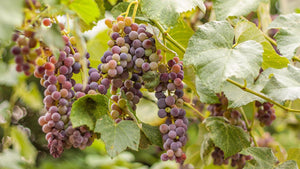 Sun, Jan 07, 2024
Sun, Jan 07, 2024Planting & Growing Grapes
-
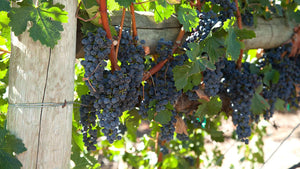 Wed, Mar 12, 2025
Wed, Mar 12, 2025When to Plant Grapes: A Complete Guide to Planting Grapes in Clay Soil and Beyond
-
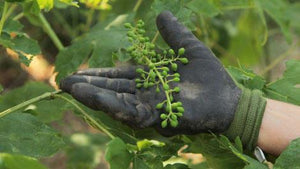 Thu, Jul 03, 2025
Thu, Jul 03, 2025Trim Grapes in Summer With Confidence: Learn How to Trim Grape Vines in Summer and the Secrets to Pruning Grape Vines During Growing Season
-
 Thu, Feb 06, 2025
Thu, Feb 06, 2025Planting & Pruning Grape Vines

